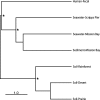Metagenomic and small-subunit rRNA analyses reveal the genetic diversity of bacteria, archaea, fungi, and viruses in soil
- PMID: 17827313
- PMCID: PMC2074941
- DOI: 10.1128/AEM.00358-07
Metagenomic and small-subunit rRNA analyses reveal the genetic diversity of bacteria, archaea, fungi, and viruses in soil
Abstract
Recent studies have highlighted the surprising richness of soil bacterial communities; however, bacteria are not the only microorganisms found in soil. To our knowledge, no study has compared the diversities of the four major microbial taxa, i.e., bacteria, archaea, fungi, and viruses, from an individual soil sample. We used metagenomic and small-subunit RNA-based sequence analysis techniques to compare the estimated richness and evenness of these groups in prairie, desert, and rainforest soils. By grouping sequences at the 97% sequence similarity level (an operational taxonomic unit [OTU]), we found that the archaeal and fungal communities were consistently less even than the bacterial communities. Although total richness levels are difficult to estimate with a high degree of certainty, the estimated number of unique archaeal or fungal OTUs appears to rival or exceed the number of unique bacterial OTUs in each of the collected soils. In this first study to comprehensively survey viral communities using a metagenomic approach, we found that soil viruses are taxonomically diverse and distinct from the communities of viruses found in other environments that have been surveyed using a similar approach. Within each of the four microbial groups, we observed minimal taxonomic overlap between sites, suggesting that soil archaea, bacteria, fungi, and viruses are globally as well as locally diverse.
Figures




References
-
- Anderson, I. C., and J. W. G. Cairney. 2004. Diversity and ecology of soil fungal communities: increased understanding through the application of molecular techniques. Environ. Microbiol. 6:769-779. - PubMed
-
- Anderson, I. C., C. D. Campbell, and J. I. Prosser. 2003. Potential bias of fungal 18S rDNA and internal transcribed spacer polymerase chain reaction primers for estimating fungal biodiversity in soil. Environ. Microbiol. 5:36-47. - PubMed
-
- Angly, F., B. Rodrigues-Brito, D. Bangor, P. McNairnie, M. Breitbart, P. Salamon, B. Felts, J. Nulton, J. Mahaffy, and F. Rohwer. 2005. PHACCS, an online tool for estimating the structure and diversity of uncultured viral communities using metagenomic information. BMC Bioinformatics 6:41. - PMC - PubMed
-
- Baker, G. C., J. J. Smith, and D. A. Cowan. 2003. Review and re-analysis of domain-specific 16S primers. J. Microbiol. Methods 55:541-555. - PubMed
Publication types
MeSH terms
Substances
Grants and funding
LinkOut - more resources
Full Text Sources
Other Literature Sources
Molecular Biology Databases

